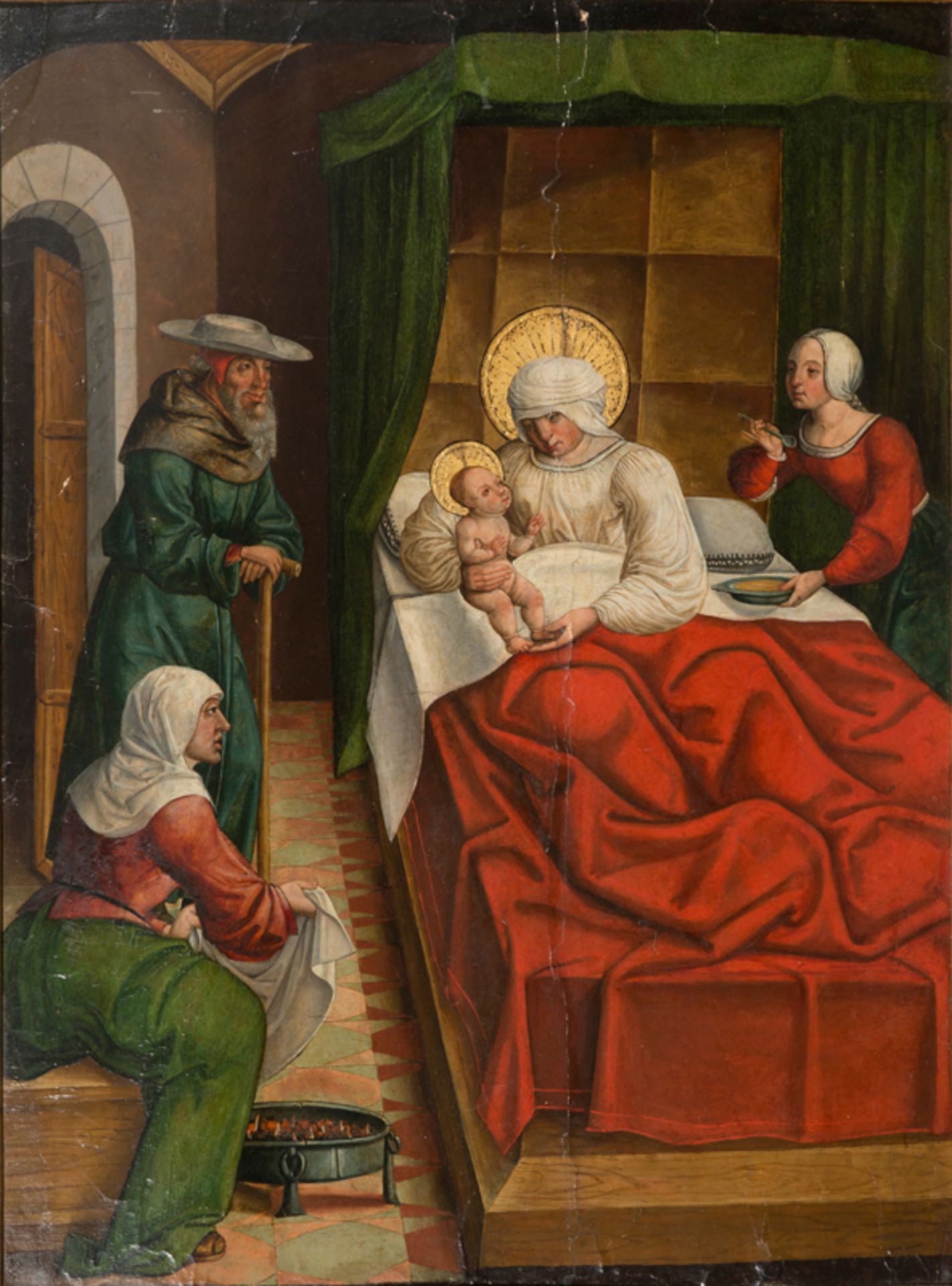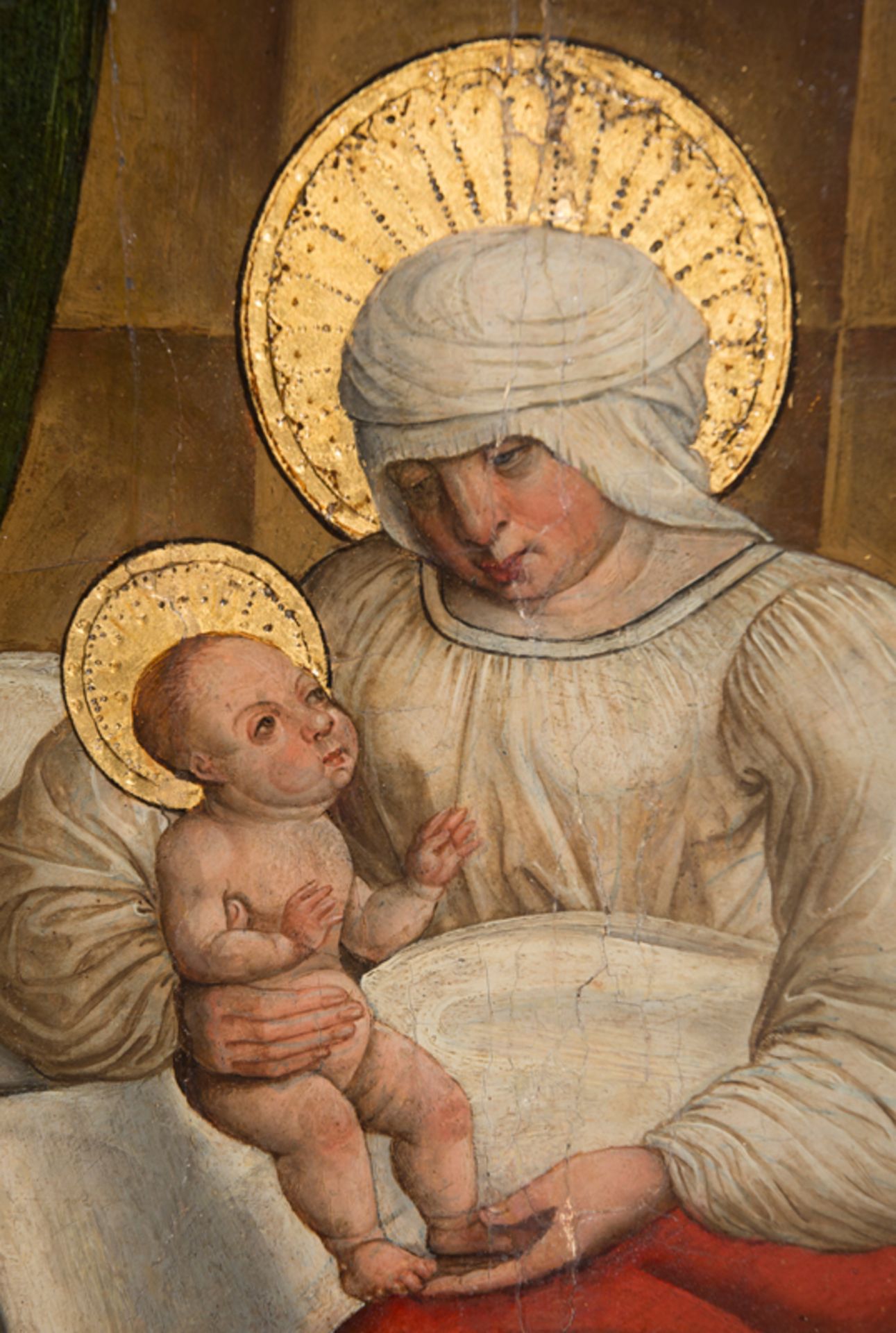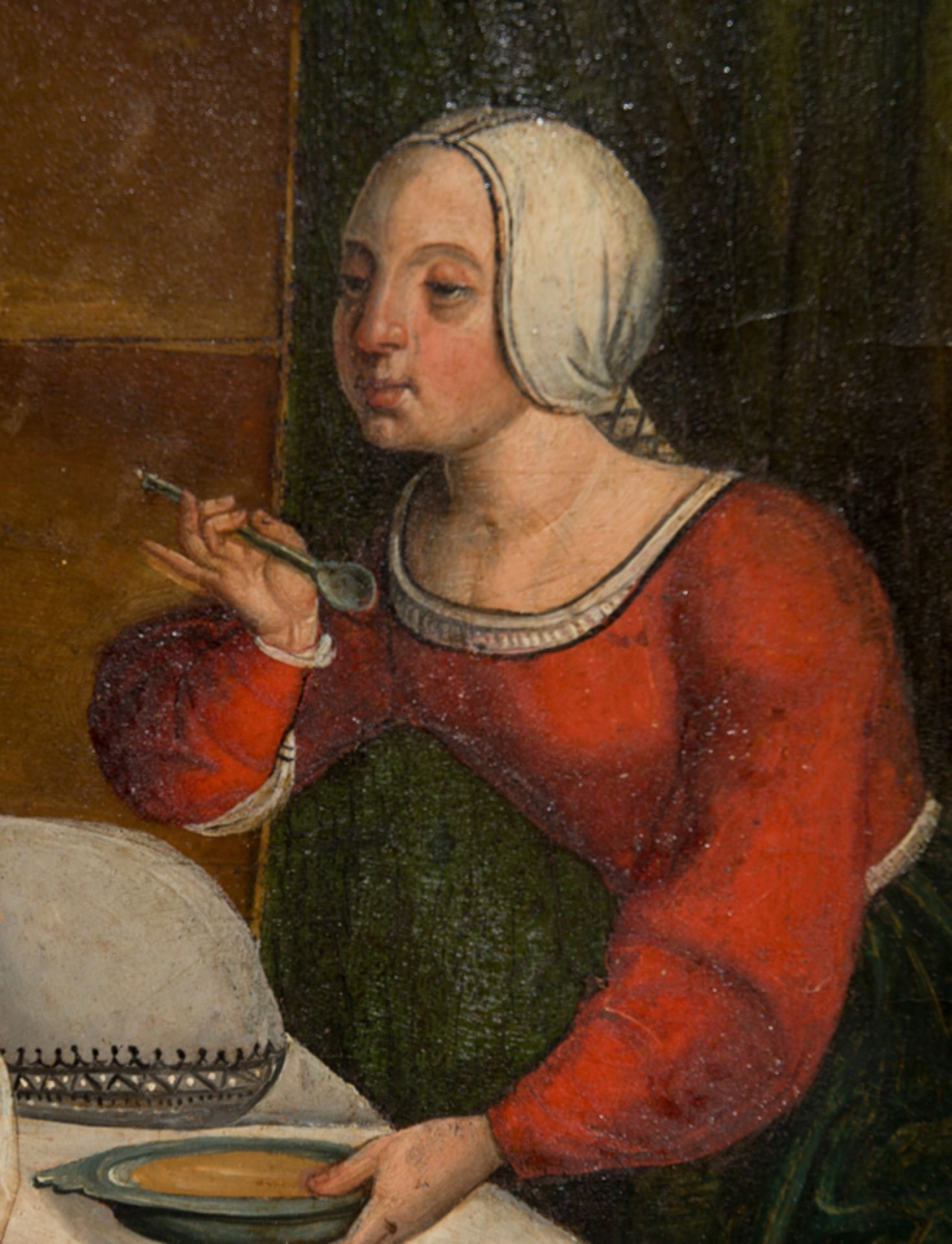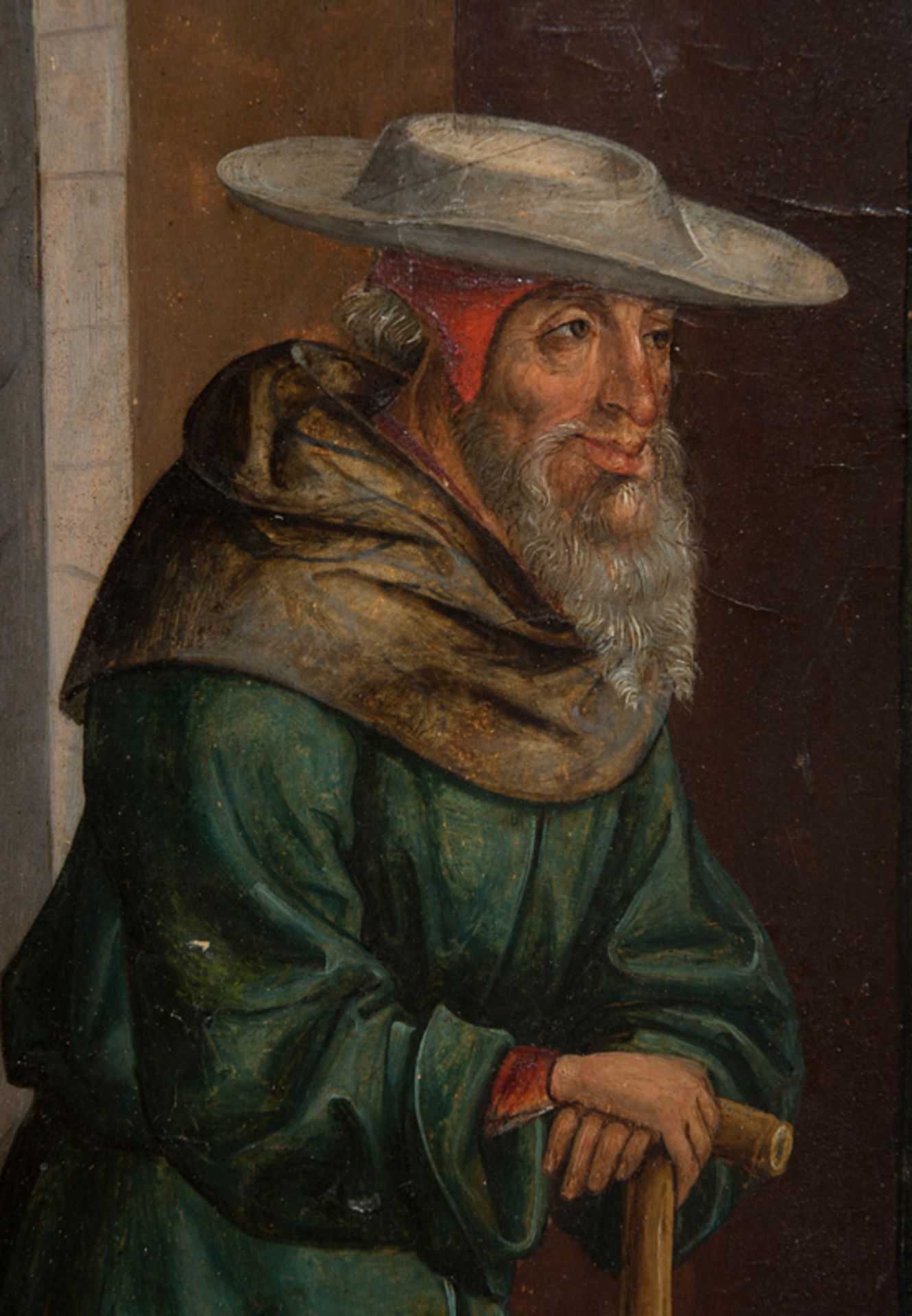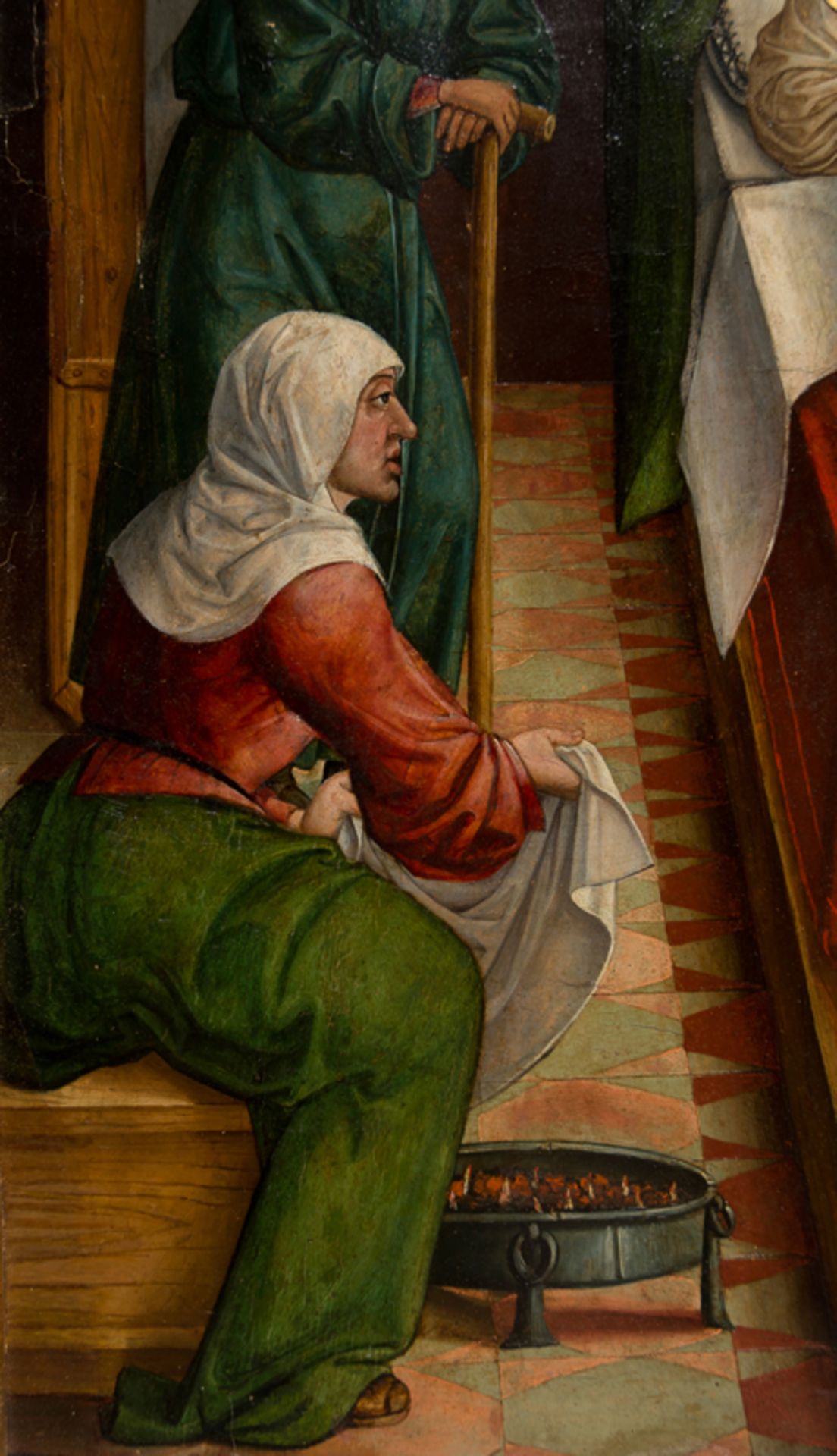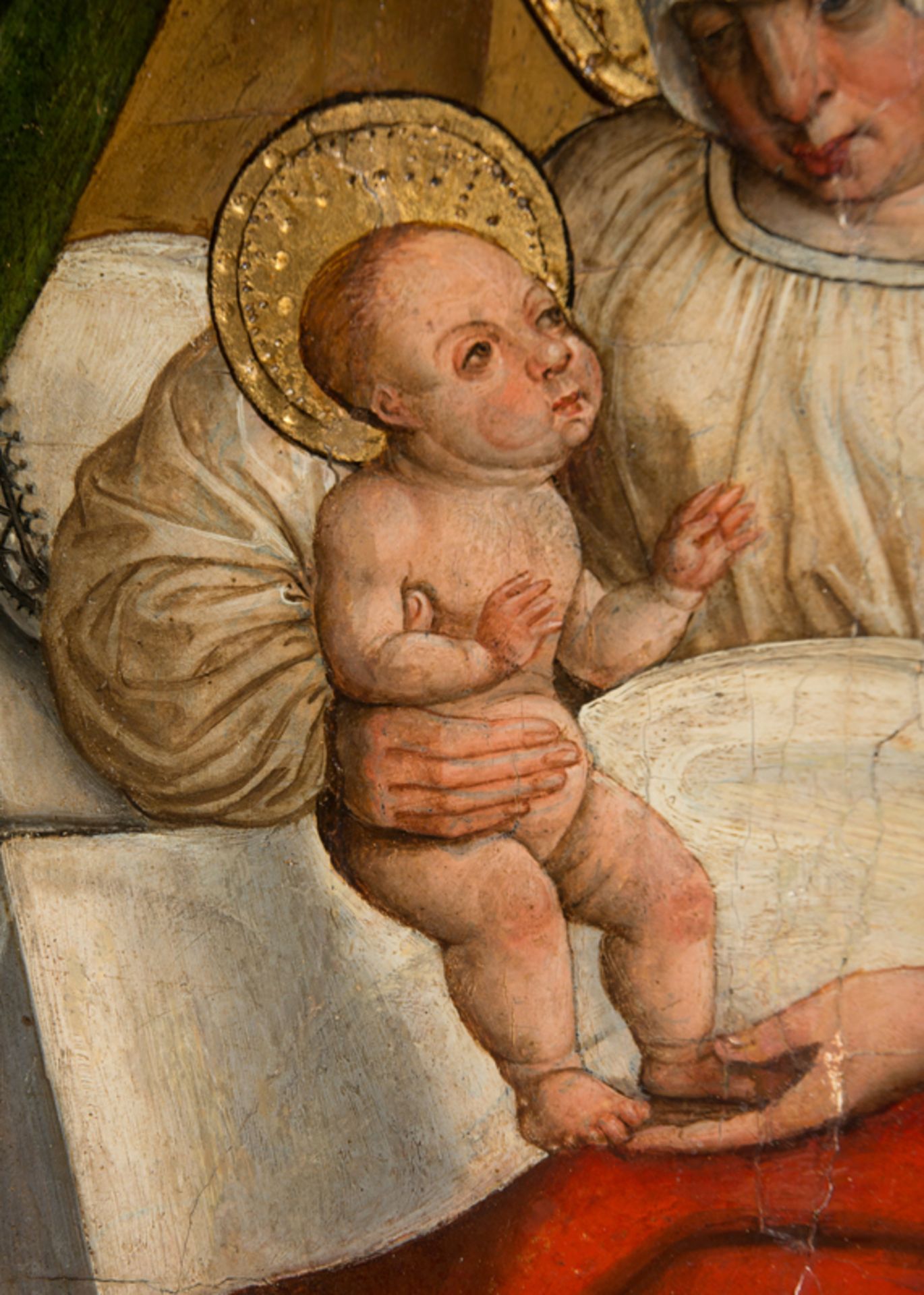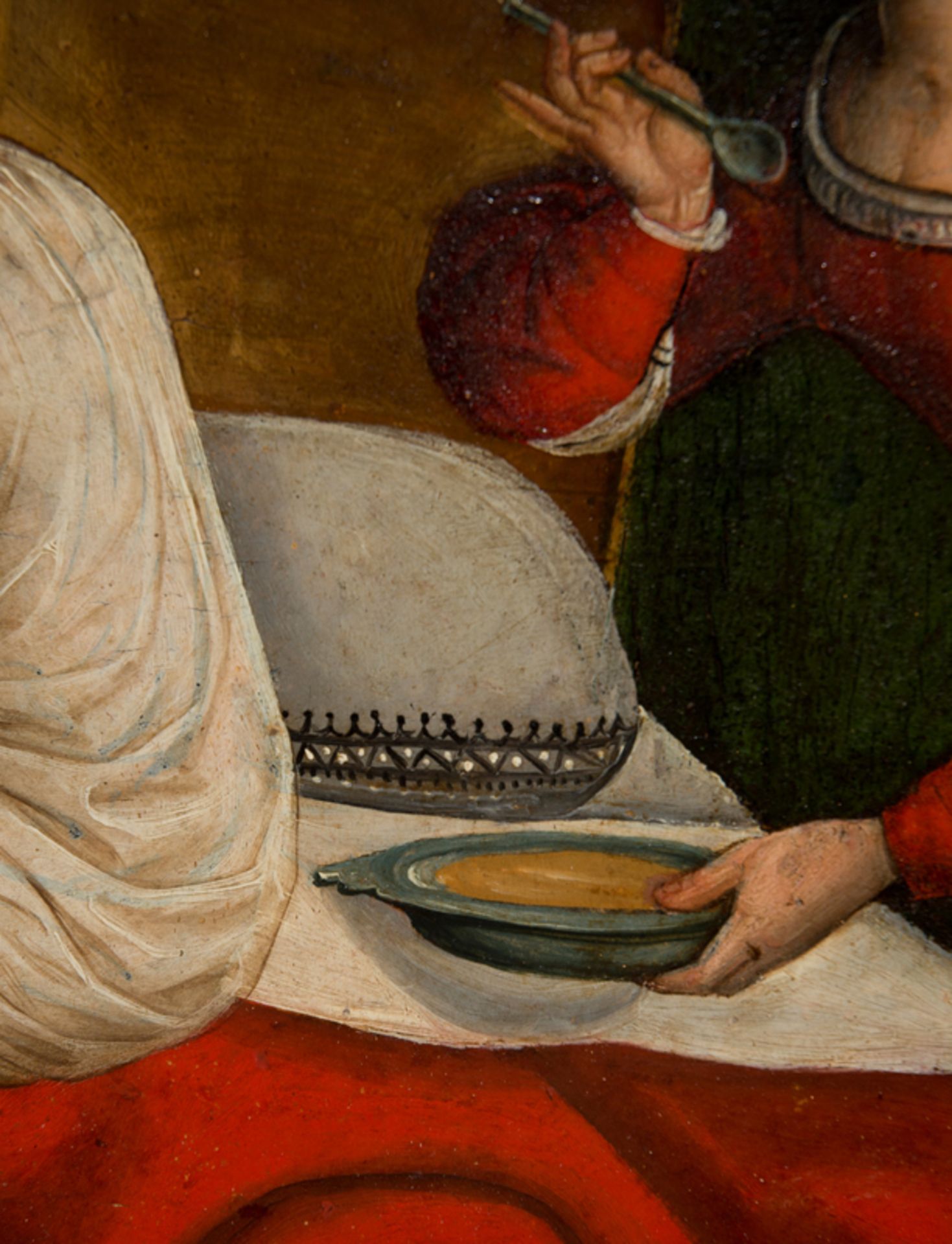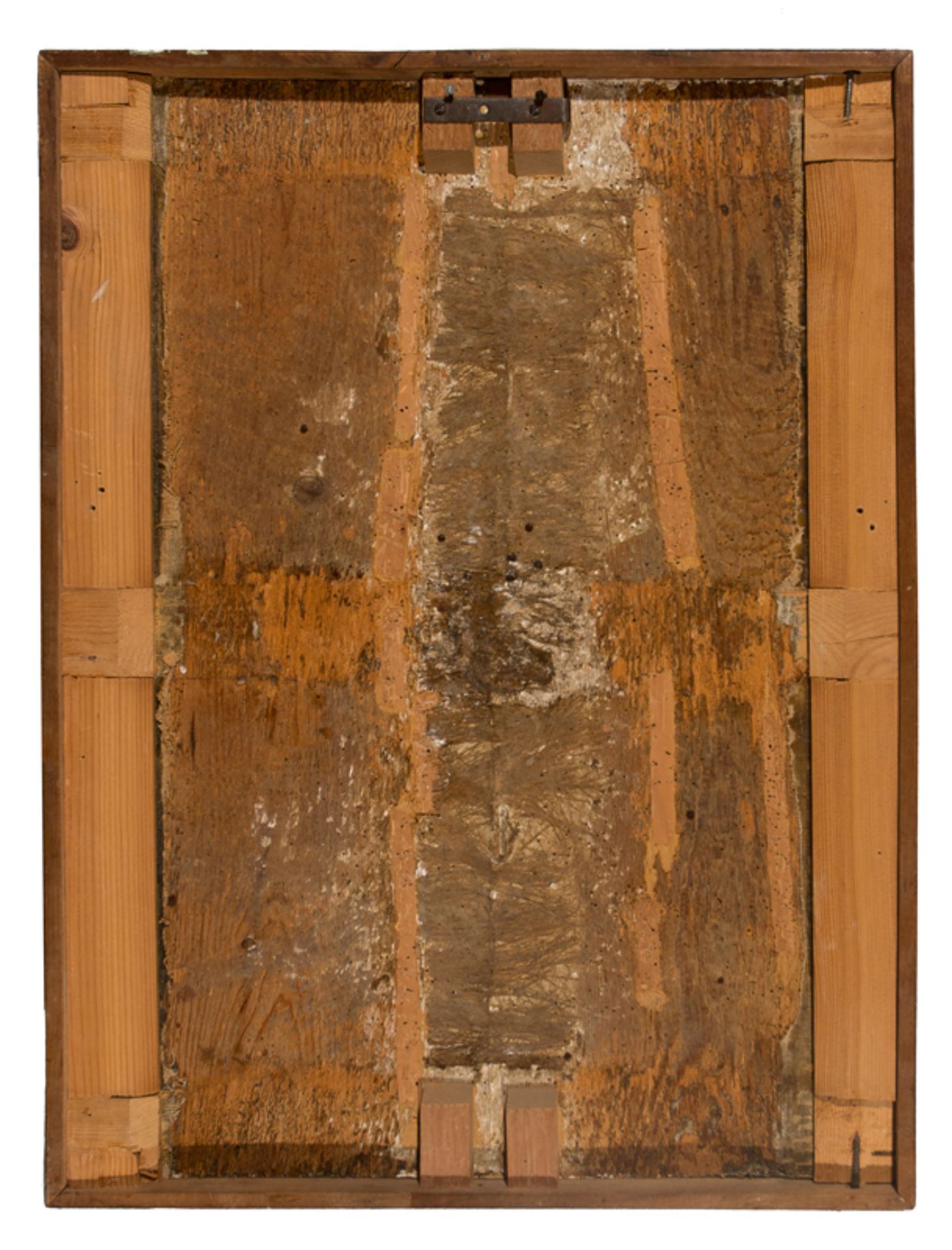18
Master Alejo (circa 1490-1530)Master Alejo (circa 1490-1530) Birth of the Virgin Mary Palencia,
Master Alejo (circa 1490-1530)
Birth of the Virgin Mary
Palencia, circa 1515-1525
Oil on panel
65 x 48 cm.
Recently Incorporated in the catalogue of paintings by the artist, this is the compartment of a reredos which, considering its dimensions, could have been part of a predella. The composition is outstanding, due to both the depth of the bed which Saint Anne rests on after having given birth to the Virgin Mary, and also the everyday feeling the scene conveys, as one of the midwives dries nappies in the heat of the stove, while the other offers a plate of food to the new mother. Just as interesting is the sweetness of the play in the looks between Anne, Joaquim and the new-born baby. With regard to the painter, “Maestro Alejo”, also known as “Maestro de la Calzada” was one of the most interesting painters of the first Renaissance in the Castile area in Spain.
As Albert Velasco notes in his study of this painting: “There is no doubt about the attribution of this painting, as it corresponds to a painter with a very peculiar and definite style, Master Alejo, active between the late 15th century and the early 16th century in the Palencia region. In this panel we can find all the characteristics that define the painter’s style, defined in SILVA 1990, vol. III, pp. 913-918) as characters with marked expressivity and prominent gestures, with very defined and personal faces, almost individualised. Their eyes are globular and bulging. Their straight, large noses have a round tip. The lips are very fleshy and always a lively red colour. The rounded and rosy cheeks are another of the painter’s characteristic features, as well as the wide, clear foreheads. The hands are usually delicate, although on occasions they are too long or their position appears abnormal. The characters always wear bright coloured clothing, with abundant, uneven folds and, occasionally, with a shiny appearance, as we can see in Joaquim’s clothes. Without a doubt, we find ourselves before a master of the late gothic style, who retains a connection with the art of Fernando Gallego, especially in the expressive and angular faces and also the treatment of the folds in the clothing.”
With regard to the artist, as Velasco notes:
“The Master Alejo is an undocumented painter who we know through a signed panel painting of the Prophet Moses which was kept in the former Josep Gudiol collection. As that was a signed painting, it was used to define the painter’s character and assemble the catalogue of his work. The discovery of that panel painting led to the fusion of the artist’s character with that of the old Maestro de Sirga, painter of two altarpieces for the church of Santa María la Blanca de Villalcázar in Sirga (Palencia), one dedicated to the Virgin Mary which presides over the main altar, and another dedicated to Saint Anthony of Padua. Considering this, there is no historiographical consensus around the Master Alejo, as while there are some who think he is a different painter from the Maestro de Calzada, others consider that both are one person, which is the case with Isabel Mateo. Those who defend the first option consider that the Maestro de Calzada (circa 1500-1530) would have trained alongside Maestro Alejo (circa 1485-1515). Personally, we conform to the second of the two proposals and prefer to consider them as one single artist.”
Sotheby’s, 5th April 1990, lot 348; Italy, private collection (2020).
Bibliography:
Isidro Puig Sanchis, “El Maestro de Portillo y el Maestro de Calzada. Sobre el dibujo subyacente y nuevas atribuciones”, Archivo de Arte Valenciano, 101, 2020, pp. 84-86, fig. 3 (reproduction)
The painting comes with Dr. Alberto Velasco’s report.
Master Alejo (circa 1490-1530)
Birth of the Virgin Mary
Palencia, circa 1515-1525
Oil on panel
65 x 48 cm.
Recently Incorporated in the catalogue of paintings by the artist, this is the compartment of a reredos which, considering its dimensions, could have been part of a predella. The composition is outstanding, due to both the depth of the bed which Saint Anne rests on after having given birth to the Virgin Mary, and also the everyday feeling the scene conveys, as one of the midwives dries nappies in the heat of the stove, while the other offers a plate of food to the new mother. Just as interesting is the sweetness of the play in the looks between Anne, Joaquim and the new-born baby. With regard to the painter, “Maestro Alejo”, also known as “Maestro de la Calzada” was one of the most interesting painters of the first Renaissance in the Castile area in Spain.
As Albert Velasco notes in his study of this painting: “There is no doubt about the attribution of this painting, as it corresponds to a painter with a very peculiar and definite style, Master Alejo, active between the late 15th century and the early 16th century in the Palencia region. In this panel we can find all the characteristics that define the painter’s style, defined in SILVA 1990, vol. III, pp. 913-918) as characters with marked expressivity and prominent gestures, with very defined and personal faces, almost individualised. Their eyes are globular and bulging. Their straight, large noses have a round tip. The lips are very fleshy and always a lively red colour. The rounded and rosy cheeks are another of the painter’s characteristic features, as well as the wide, clear foreheads. The hands are usually delicate, although on occasions they are too long or their position appears abnormal. The characters always wear bright coloured clothing, with abundant, uneven folds and, occasionally, with a shiny appearance, as we can see in Joaquim’s clothes. Without a doubt, we find ourselves before a master of the late gothic style, who retains a connection with the art of Fernando Gallego, especially in the expressive and angular faces and also the treatment of the folds in the clothing.”
With regard to the artist, as Velasco notes:
“The Master Alejo is an undocumented painter who we know through a signed panel painting of the Prophet Moses which was kept in the former Josep Gudiol collection. As that was a signed painting, it was used to define the painter’s character and assemble the catalogue of his work. The discovery of that panel painting led to the fusion of the artist’s character with that of the old Maestro de Sirga, painter of two altarpieces for the church of Santa María la Blanca de Villalcázar in Sirga (Palencia), one dedicated to the Virgin Mary which presides over the main altar, and another dedicated to Saint Anthony of Padua. Considering this, there is no historiographical consensus around the Master Alejo, as while there are some who think he is a different painter from the Maestro de Calzada, others consider that both are one person, which is the case with Isabel Mateo. Those who defend the first option consider that the Maestro de Calzada (circa 1500-1530) would have trained alongside Maestro Alejo (circa 1485-1515). Personally, we conform to the second of the two proposals and prefer to consider them as one single artist.”
Sotheby’s, 5th April 1990, lot 348; Italy, private collection (2020).
Bibliography:
Isidro Puig Sanchis, “El Maestro de Portillo y el Maestro de Calzada. Sobre el dibujo subyacente y nuevas atribuciones”, Archivo de Arte Valenciano, 101, 2020, pp. 84-86, fig. 3 (reproduction)
The painting comes with Dr. Alberto Velasco’s report.
Galleons: The Meeting Between the Old and New World
Sale Date(s)
Venue Address
General delivery information available from the auctioneer
The purchase price includes the delivery of the lots in the venue of the auction. Transporting to other destinations is at the own risk of the client. The customer must contact "LST", to give the corresponding instructions for such transporting. "LST" is not responsible for the packaging or any accident incurred during transportation.
Important Information
Aufgeld/Premium: 22 %, USt auf Aufgeld/VAT on premium: 21 %
Terms & Conditions
CONDITIONS OF THE AUCTION:
I. REGISTRATION. To bid in the room customers must register at the beginning, filling out a form and picking a number that will identify them during the auction. Customers may be required to register in bank references or other guarantee system and if they do not prove the solvency "LST" will not accept bids and award the auction.
II. WRITTEN BIDS. "LST" will accept written bids, which will be formalized in the form provided by the room until the day before the auction. In such auctions, the room will bid in name of the client until the maximum stated in the offer and always at the lowest possible price. If there are two or more bids for the same amount, the one placed first will have the priority. Written bids received in advance, will have priority on the day of the auction.
III. TELEPHONE BIDS. "LST" will allow telephone bids, if interested people contact "LST" days before the auction providing personal data, ID card and the phone number which will be used by the staff of "LST" to call at the time of the auction. The buyer, within all the legal rights is making an offer for the asking price, when applies for telephone bid. "LST" will not take responsibility for any technical defects beyond its control, which may prevent to contact successfully the bidder during the auction.
IV. AUCTIONEER. The auction will be conducted by an auctioneer, director of the auction will be judge and arbitrator of it with full authority in its development, will award the lots to the highest bidder and is able to settle any controversy concerning lots sale, reject bids, divide lots or group them and remover objects from the room. Will be able to, if it is deemed suitable, not accept bids on the auction. His decision will be unappealable.
V. SALE OF LOTS. The lots are awarded to the highest bidder. Once the auctioneer blows the hammer, the buyer becomes responsible of the lot purchased, exempting "LST" of liability to for any damage and / or accidents that may occur. No refunds of lots.
VI. STARTING PRICE. The amount shown in the catalogue as the starting price for each lot will be, as a rule, the minimum selling price, except for exceptional cases where a reservation may be agreed upon with the seller or it set discretionary by the room.
VII. SCALE OF BIDS. The bids are set according to the following scale:
From 50.-€ to 200.-€…………………………………………..at 10.-€
From 200.-€ to 500.-€…………………………………… …25 in 25.-€
From 500.-€ to 1.000.-€………………………………..…..….50 in 50.-€
From 1.000.-€ to 2.000.-€………………………………..…100 in 100.-€
From 2.000.-€ to 5.000.-€……………………………….….250 in 250.-€
From 5.000.-€ to 10.000.-€…………………………………500 in 500.-€
From 10.000.-€ to 20.000.-€……………………………1.000 in 1.000.-€
From 20.000.-€ to 50.000.-€……………………………2.500 in 2.500.-€
From 50.000.-€ to 100.000.-€…………………………..5.000 in 5.000.-€
From 100.000.-€ to 100.000.-€………………………10.000 in 10.000.-€
From 200.000.-€ to 200.000.-€………………………25.000 in 25.000.-€
From 500.000.-€ to 500.000.-€………………………50.000 in 50.000.-€
VIII. RIGHT OF ADMISION. "LST" reserves the right to admission to the auction room and to reject, at its judgment, any purchase order, from clients whose solvency is not duly proved as well as not to sale auctions.
IX. SALE PRICES. The successful bidder of one or more lots must pay "LST" the final sale price achieves at auction, plus the 22 % plus 21% VAT on the commission, at total 26,62 % on Hammer Price.
X. CATALOG DATA. The catalogue data are obtained in order to careful research and advice, however, any responsibility is afforded about its accuracy. The lots will be auctioned in the state in which they are, not accepting any claims in restorations, breakage, damage, imperfections and, even description or numbering mistakes in the catalogue, in case of it, being the burden of the buyers to make sure before the auction that the description matches with their personal opinion about respective lot. The exhibition of the lots is intended to allow a perfect review and study of them.
XI. PAYMENT AND REMOVAL OF LOTS. Payment and removal of the lots will be held no later than five days following the auction. After this period expire without having the buyer removed the lot or lots purchases, it will accrue an expense of custody of 6 euros per day on each lot.
15 days after the auction without having the buyer paid and removes the sold lots, "LST" will inform the seller and there will begin judicial proceeding in order to obtain payment. The delay in payment by the purchaser of his/her sold lots will carry an interest increase at a rate of 1,5% per month.
XII. DELIVERY OF LOTS. The purchase price includes the delivery of the lots in the venue of the auction. Transporting to other destinations is at the own risk of the client. The customer must contact "LST", to give the corresponding instructions for such transporting. "LST" is not responsible for the packaging or any accident incurred during transportation.
XIII. RIGHT OF FIRT REFUSAL AND REPURCHASE. "LST" in order to article 38 of "Ley 16/1985 de 25 Junio del Patrimonio Histórico Español" (BOE. 155 June 29, 1985), will notify in advance to the Ministry of Culture, the content of their catalogues. Concerning the lots subject to the legislation referred to in the preceding paragraph, the Administration may exercise the rights of first refusal and repurchase according to the law. "LST" will watch over the protection of Artistic, Historical and Bibliographical Heritage of Spain. For customers out of European Community, a tax for export is required by the Administration.
XIV. VALUE ADDED TAX (I.V.A). This tax will be accrued on commissions of "LST" for buyers, using the rates prevailing on the date of the auction.
XV. DATA PROTECTION. In order to the "Ley 15/1999 de 13 de Diciembre, de Protección de Datos de Carácter Personal", the client authorize "LST", the inclusion of their data in a customer file, and for the promotion by "LST" of the objects at all times the rights of access, rectification or deletion of personal data by sending the appropriate request to the following address: LA SUITE SUBASTAS, C/ Conde Salvatierra, 8, 08006. Barcelona.
XVI. EXPRESS LEGAL JURISDICTION. These Conditions are governed by and interpreted in accordance with the rules of Spanish law. The mere act of participating in the auction as seller, buyer or bidder, implies acceptance of these Terms and Conditions.
Sales operations are understood to be held at the registered office of "LST", C/ Conde de Salvatierra, 8, 08006. Any dispute shall be taken to the competent courts of Barcelona, expressly waiving any other jurisdiction, in accordance with Article 55 of the "Ley de Enjuiciamiento Civil".


















